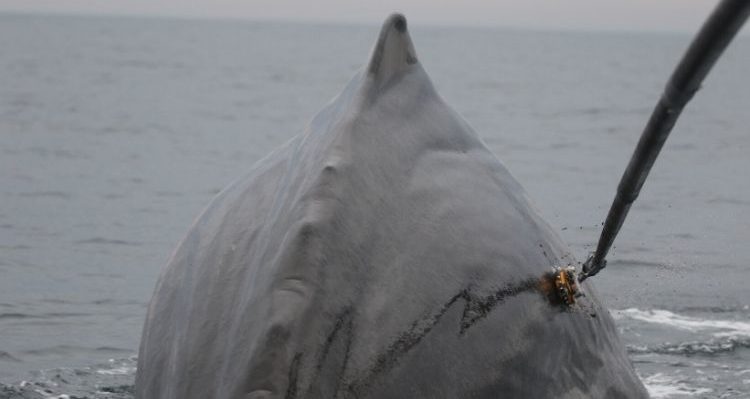New sonar still deters sperm whales feeding

New sonar technology is as disruptive to sperm whales as existing sonar technology, according to new research led by the University of St Andrews.
While pulsing sonar has been used by navies around the world for years, the effect of new continuous sonar on sea mammals had not been tested before.
Now, an international team of researchers led by Professor Patrick Miller at the University of St Andrews has examined the impact of this new technology on sperm whales with the first at-sea experiments.
Professor Miller of the Sea Mammal Research Unit (SMRU) at the University of St Andrews said: “Having set up similar experiments with sperm whales in Norway before, we already had data on their responses to pulsed sonar.
“Although whales responded to the new continuous sonar at a lower received sound level, the impact of the two sonar systems on feeding behaviour was similar. Continuous sonar pulses are transmitted at lower level, with signal energy content essentially just spread out over longer duration pulses.
“Indeed, we found that signal energy content predicted when sperm whales would stop foraging, both during the continuous sonar and higher-amplitude pulsed sonar exposures.”
Underwater noise pollution is a concern for species such as whales and dolphins which rely on sound for feeding, navigation and communication. Besides unintentional noise, such as the noise produced by a ship’s propeller, noise can also be generated intentionally, such as in echo sounding (sonar).
Underwater sonars have wide-ranging applications from fish-finding to oil exploration. Navies use sonar in anti-submarine warfare and naval sonar has been shown to impact whale and dolphin behaviour and been associated with stranding of deep-diving beaked whales.
Typically, sonars such as fish finders emit and listen for sound pulses. Listening for the echoes of multiple pulses allows sonar users to build a picture of the environment. However, navies are now moving towards new technology that allows for more continuous emission and listening of sonar at the same time.
More continuous sonar emissions mean fewer gaps in the generated noise, raising concern over their environmental impact. This could increase masking of biologically important sounds for marine life. On the other hand, the new continuous systems are also capable of using lower acoustic levels, which could mitigate their impact.
The experiments involved finding and tagging sperm whales at sea using suction-cup attached data loggers. A large international team of scientists and technicians worked on board the Norwegian research vessel H.U. Sverdrup II for several weeks at a time.
Besides being the main base of operations, the vessel was used to tow the custom-built sonar source by the project’s Dutch collaborators. The source was used to transmit different sonar signals at a controlled distance from the tagged whale to ensure safe sound levels.
The experiments revealed that sperm whales stop foraging during both types of sonar exposures. The researchers found that greater sound energy (the total energy content of the signal including its duration) was more likely to deter sperm whales from feeding than sound amplitude (the instantaneous loudness of a signal regardless of its time duration). Thus, reducing sonar signal energy content could help navies to reduce impacts.
Lead author Dr Saana Isojunno, Research Fellow at SMRU, said: “Our research also examined the effect of other potential competitor or predator species, pilot whales and killer whales, on sperm whale feeding.
“While the presence of these species didn’t put sperm whales off feeding, their presence did make the sperm whales even more responsive to sonar so it seems to indicate sperm whales are extra vigilant to sonar after such an encounter.”
The paper, ‘When the noise goes on: received sound energy predicts sperm whale responses to both intermittent and continuous navy sonar’ by Saana Isojunno, Paul J Wensveen, Frans-Peter A Lam, Petter H Kvadsheim, Alexander M von Benda-Beckmann, Lucia M Martin Lopez, Lars Kleivane, Eilidh M Siegal and Patrick Miller is published in the Journal of Experimental Biology available online.
DOI: 10.1242/jeb.219741.
Figure caption: Attaching a data logger on a sperm whale to measure their foraging behaviour during controlled exposure experiments. Sperm whales were more likely to respond to navy sonar following pilot whale and killer whale encounters.
Sound clip caption: Sperm whales often continued to echolocate during sonar exposures. You can hear the rapid 'buzz' clicks, indicating prey capture attempt, with the 1-2 kHz continuous active sonar sound in the background.
Issued by the University of St Andrews Communications Office.